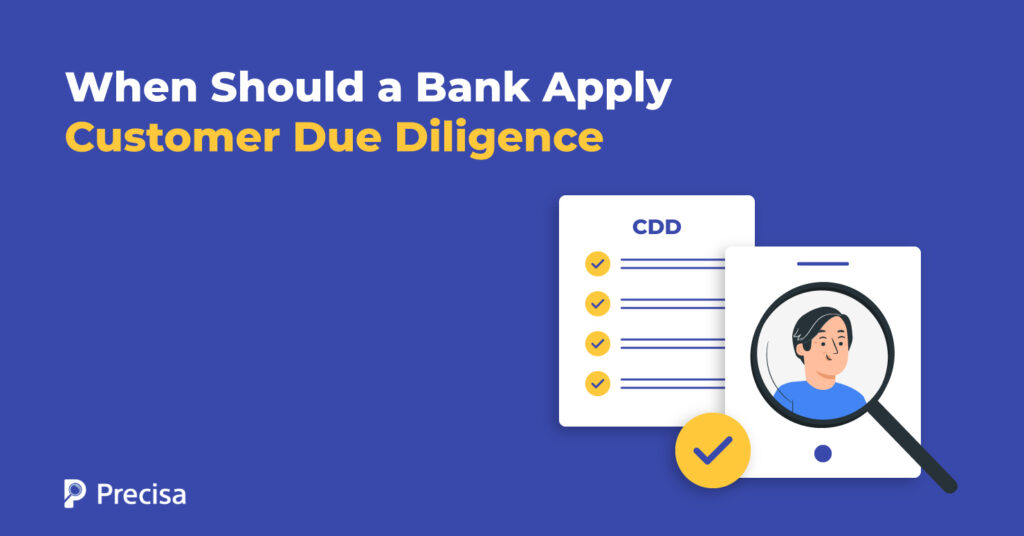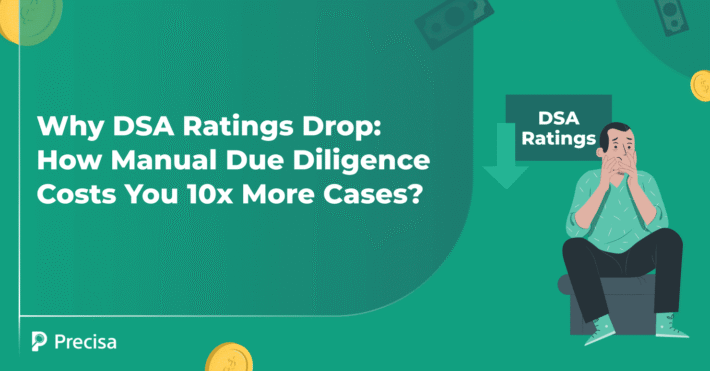When Should a Bank Apply Customer Due Diligence: Aligning Timing with Evolving Guidelines

When it comes to fighting financial crimes like money laundering and financing of terrorism, deciding when should a bank apply Customer Due Diligence (CDD) has become critical.
Knowing your customer remains one of the primary bulwarks and one of the four fundamental components of an Anti-Money Laundering (AML) compliance programme. This entails confirming customers and their operations, the type of operations they carry out, and the associated risk factors to ensure compliance and contain potential risks.
Despite its importance, 2023 reports indicate that 60% of firms lack adequate AML and CDD processes, failing to meet regulatory standards.
So, let’s explore more about CDD more and how a bank can benefit from it.
What is Customer Due Diligence?
Customer due diligence is a process through which a financial institution or a business understands who its customers are and what risks may be involved in doing business with them.
It entails sourcing information belonging to the customer, including their identification, economic activity, source of income, and business with the enterprise in question.
The purpose of CDD is to help organisations appreciate their clientele and understand whether they are linked to illegitimate ventures. Thus, organisations performing proper due diligence can build a customer base trust rate, improve RMs, and adhere to legal frameworks.
When Should a Bank Apply Customer Due Diligence?
To answer this question, let us look at the important situations that require Customer Due Diligence (CDD) to protect financial institutions and their clients.
1. Welcome Process for New Customers
When a bank gets a new customer, it’s important to check their identity, address, and where their money comes from. This builds trust for future transactions.
For example, if a bank gets a new business client, it will verify the business’s identity, check who owns it, understand its business model, and know what kind of transactions it plans to make.
2. High-Risk Customers
Some customers or businesses are riskier because of what they do or where they are located. Enhanced Due Diligence (EDD) is used in these cases to investigate potential risks more thoroughly.
EDD includes verifying sources of wealth, identifying hidden owners, conducting rigorous background checks, and monitoring transactions closely for suspicious activity. Ongoing risk assessment ensures vigilance and any changes in the customer’s situation are carefully reviewed.
For instance, if a bank deals with a customer in a politically unstable area, it will check the customer’s identity and source of funds and investigate their background and connections to avoid corruption.
3. Unusual Transactions
CDD helps banks watch for unusual transactions that might mean money laundering or fraud. Spotting these red flags proactively can prevent crimes.
For example, if someone who usually doesn’t make large transactions suddenly does so, the bank will look closer to make sure everything is legitimate.
4. Politically Exposed Persons (PEPs)
Checking customers against lists of PEPs and sanctions helps banks avoid dealing with people involved in corruption or crime. This is important when the customer holds or is connected to a public office. The bank will compare customer information with global databases to spot any connections to PEPs.
5. Changes in Customer Information
Keeping an eye on customers is important because their risk level can change. If a customer’s financial activity suddenly increases, CDD systems will notice this change, prompting the bank to reassess the risk.
6. Overseas Transactions
International transactions have their own risks, and CDD helps banks identify these risks.
For example, when handling cross-border payments, banks verify that the transactions are legitimate, understand why the money is being sent, and ensure compliance with local and international rules.
What are the Best Ways to Do Customer Due Diligence Well?

Here are the common steps to help the organisation stay committed to the highest standards of due diligence:
1. Thorough CDD Policy
Writing a clear and detailed CDD policy is essential. This policy should explain how the institution assesses risk, identifies customers, monitors activities, and handles potential issues.
2. Staff Training Regularly
Well-trained staff are key to effective CDD. Regular training keeps employees informed about the latest rules, financial crime trends, and the importance of CDD in protecting the institution.
3. Teamwork Among Departments
In the path of knowing when should a bank apply Customer Due Diligence, It should involve more than just the compliance department. Collaboration between compliance, risk management, and customer service ensures a strong defence against financial crimes. Robust communication channels should be set up to address any problems quickly.
4. Employing AI-powered tools
Harnessing AI-driven tools like Precisa in CDD empowers financial institutions with enhanced efficiency and accuracy. Automated risk assessment models quickly identify potential threats, while real-time transaction monitoring catches suspicious activity early on.
Automation also frees up valuable resources for in-depth analysis, ultimately reducing costs and improving the customer experience through faster onboarding.
Common Challenges of CDD
Here are some challenges you must navigate while conducting CDD:
- Balancing Customer Experience and Security: Finding the right balance between efficient onboarding and robust security checks.
- Adapting to Evolving Threats: Keeping pace with the constantly changing landscape of financial crime and adjusting CDD practices accordingly.
- Cost and Resource Management: Allocating adequate resources and budget to implement and maintain effective CDD programs.
- False Positives: Managing the risk of false positives, where legitimate customers are flagged for additional scrutiny, leading to potential frustration and delays.
Final Takeaway
As banks and other financial institutions strive to improve their performance by designing more innovative products and services, understanding when should a bank apply customer due diligence has remained relevant.
Implemented at the right time, serves as a shield for finance-related crimes and preserves the image of institutions. This is because CDD and compliance with the regulations go hand in hand, proving the necessity of this practice.
The usefulness and relevance of CDD cannot be judged by its ability to conduct comprehensive financial background studies of groups and individuals but rather by its effectiveness in identifying new and emerging threats.
By using CDD strategically, banks support ethical finance practices and help enhance the security of banking systems worldwide.
And if you need a powerful tool to enhance the finance practice by analysing the financial statements of loan applicants on a large scale, Precisa is a perfect choice. Try our 14-day free trial today.



